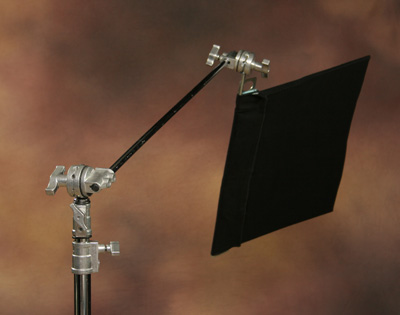This is probably an easy one, but I can't figure it out for the life of me. I want to know how I can light certain objects, but not others. For instance, I have an interior scene in a living room, and I want to light the subject in the foreground but keep the background dark. My problem? When I turn on the lights (aimed at the subject in the foreground) it floods the entire room, lighting everything! And when I try angling the lights so that they fall on just the subject, it never works because then I have large pools of light falling all over the place and everything looks very uneven. Is there some trick to get the light to fall just on the subject and nothing else? Thanks to whoever can help.
By the way, I'm using work lights I bought from Home Depot. is this my problem? And if so, how do I remedy it (cheaply)?
I don't know much about lighting but I think you might try creating a mask, that is a piece of something (wood, metal, posterboard) with a cut-out shape of what you want lit. That way the light pours through the cut-out and the rest is blocked. A very specific spotlight in effect.
Of course if using poster-board be aware that lights can be very hot.
RJSchwarz
San Diego, CA
RJSchwarz
You can make a "snoot" from any thick paper if you are using a
cool light source like a clamp on work light.
http://www.doityourself.com/invt/u239921
A hotter source needs black wrap. That?s a thick, black aluminum
foil used on all sets to control where light falls.
http://www.studiodepot.com/store/index.cgi?cmd=view_item&parent=&id=7081
Make a tube of the diamater you want and place it over the light.
=============================================
The aim of an argument or discussion should not be victory, but progress.
Joseph Joubert, essayist (1754-1824)
=============================================
The aim of an argument or discussion should not be victory, but progress.
Joseph Joubert, essayist (1754-1824)
quote:
Originally posted by SinJin
This is probably an easy one, but I can't figure it out for the life of me. I want to know how I can light certain objects, but not others. For instance, I have an interior scene in a living room, and I want to light the subject in the foreground but keep the background dark. My problem? When I turn on the lights (aimed at the subject in the foreground) it floods the entire room, lighting everything! And when I try angling the lights so that they fall on just the subject, it never works because then I have large pools of light falling all over the place and everything looks very uneven. Is there some trick to get the light to fall just on the subject and nothing else? Thanks to whoever can help.By the way, I'm using work lights I bought from Home Depot. is this my problem? And if so, how do I remedy it (cheaply)?
Professional DPs, Gaffers, and Grips typically use C-stands and "flags" and "grip singles/doubles" to control the light that falls on the set.
How YOU can achieve it without professional equipment is something you may have to figure out on your own based on the resources you have available. But for reference to build on, here is a photo that may help guide you:
You can also find pictures and purchasing options at professional equipment companies, such as Filmtools in Burbank, CA ( ?url? http://www.filmtools.com/gripligcon.html?/url? ) and Studio Depot/Mole Richardson in Hollywood, CA ( ?url? http://www.studiodepot.com/store/index.cgi?cmd=view_category&parent=1008-1141&id=1241 ?/url?)
Snoots generally only work on inanimate objects as they direct the light in a very specific way. To light the talent but not have that key light fall on the background requires the use of at least one C-Stand and a "solid" flag that cuts the light from falling off onto the background. Since every setup is different, as the blocking and camera angles vary, the method to light the talent and background separately could also vary.
It can also help you to inquire about specific lighting questions at ?url?www.cinematography.com?/url?. Many working professionals regularly post there and are always more than happy to help.
Good luck!
Brian Dzyak
Cameraman/Author
IATSE Local 600, SOC
http://www.whatireallywanttodo.com
Brian Dzyak
Cameraman/Author
IATSE Local 600, SOC
http://www.whatireallywanttodo.com
http://www.realfilmcareer.com



